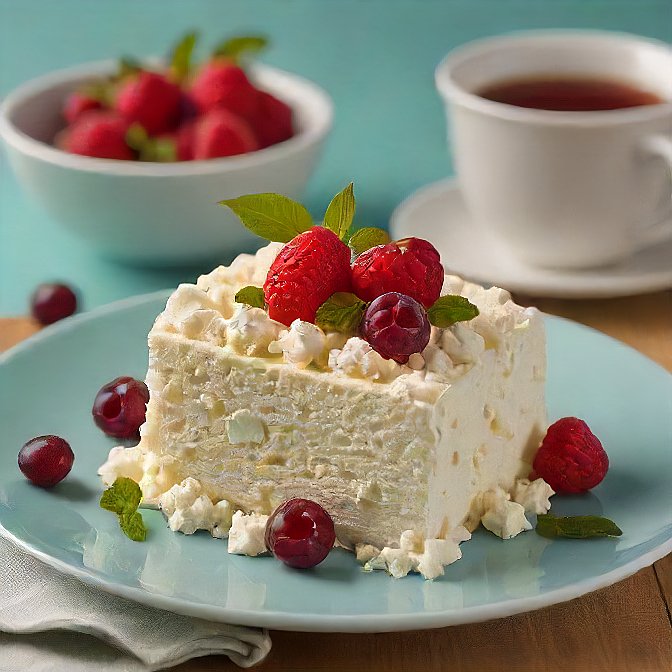In the quest for desserts that satisfy sweet cravings without compromising on health, the cottage cheese dessert emerges as a standout choice. Esteemed for its rich, creamy texture and versatile flavor profile, cottage cheese serves as a perfect base for concoctions that are both indulgent and nourishing. With an increasing number of individuals striving to maintain a balanced diet while still enjoying the finer aspects of dining, the importance of such guilt-free pleasures cannot be overstated. Not only do these desserts offer a delightful end to any meal, but they also align with dietary goals by being high in protein and low in calories.

This article delves into the unique qualities that make cottage cheese an ideal dessert ingredient, highlighting the health benefits associated with cottage cheese desserts. It will introduce readers to a variety of popular cottage cheese dessert recipes, offering step-by-step guidance on preparing a delectable chocolate cottage cheese pudding. Additionally, tips for customizing these desserts to suit individual tastes and dietary requirements will be shared. By exploring the comprehensive nature of cottage cheese as a dessert option, this discussion aims to inspire both novices and seasoned cooks to incorporate this versatile ingredient into their culinary repertoire, ensuring a balance of flavor and nutrition.
What Makes Cottage Cheese a Perfect Dessert Ingredient
Cottage cheese is celebrated for its versatility and nutritional value, making it an exceptional choice for desserts. This section explores why cottage cheese is such a favored ingredient among those looking to indulge healthily.

Nutritional Benefits
Cottage cheese is a powerhouse of essential nutrients, offering a wealth of benefits in a low-calorie package. It is an excellent source of B vitamins, calcium, phosphorus, and selenium. These nutrients are crucial for energy production, bone health, and antioxidant protection. Additionally, it contains a significant amount of high-quality protein, which is vital for muscle repair and growth. For those managing their weight or muscle mass, incorporating cottage cheese into desserts can be a strategic choice.
High Protein Content
The protein in cottage cheese is predominantly casein, which is slow-absorbing, making it ideal for sustained energy and muscle synthesis. This is particularly beneficial when consumed before bed, as it aids in metabolism and muscle recovery overnight. With about 28 grams of protein per cup, as noted by the U.S. Department of Agriculture, it’s a robust addition to any diet, especially for those increasing their protein intake without substantial calories.
Low Calorie Count
One of the most compelling reasons to use cottage cheese in desserts is its low calorie count. A 100-gram serving of low-fat cottage cheese contains just about 84 calories but is rich in protein and essential nutrients. This makes it a guilt-free base for creating satisfying desserts that don’t compromise nutritional goals. Whether blended into smoothies, mixed into batters, or used as a topping, its creamy texture and mild flavor make it an excellent substitute for higher-calorie ingredients like creams or full-fat cheeses.
By choosing cottage cheese as a dessert ingredient, individuals can enjoy a delicious treat that aligns with their health and dietary goals, making it a smart choice for a balanced lifestyle.
Health Benefits of Cottage Cheese Desserts
Cottage cheese is more than just a versatile ingredient for savory dishes; it also offers significant health benefits when incorporated into desserts. This section explores how desserts made with cottage cheese can contribute positively to one’s health, focusing on weight management, muscle recovery, and long-term satiation.

Supports Weight Loss
Cottage cheese desserts are an excellent choice for those looking to manage their weight without sacrificing the pleasure of a sweet treat. With a high protein content and low calorie count, cottage cheese provides a feeling of fullness with fewer calories. For instance, a 100-gram serving of low-fat cottage cheese contains just about 84 calories. This makes it a superb base for desserts, allowing for indulgence without the guilt. Moreover, the presence of dietary calcium in cottage cheese not only supports bone health but also helps in maintaining a healthy metabolism, which is crucial for weight loss.
Promotes Muscle Recovery
The high-quality protein in cottage cheese, predominantly casein, is essential for muscle repair and growth. Casein is a slow-absorbing protein that works throughout the night to aid in muscle recovery and prevent muscle breakdown. This makes cottage cheese an ideal ingredient for post-workout desserts. A study highlighted in the British Journal of Nutrition noted that consuming cottage cheese before bed could enhance muscle quality and metabolism. This property is particularly beneficial for athletes or anyone engaged in regular physical activities as it supports the regeneration of muscle tissue and overall muscle health.
Satiates Hunger Long-term
Cottage cheese is not only nutritious but also very effective in promoting long-term satiety. This is due to its high protein content, which takes longer to digest. This slower digestion process helps in curbing cravings and reducing the urge to snack excessively between meals. For example, just ½ cup of cottage cheese includes 12 grams of protein, which can significantly prolong the feeling of fullness. This makes cottage cheese desserts a smart choice for those who are managing their appetite and trying to adhere to a healthier eating schedule.
By integrating Cottage Cheese Dessert into desserts, individuals can enjoy delicious treats that also contribute to their health goals. Whether it’s aiding in weight loss, supporting muscle recovery, or providing long-term satiation, cottage cheese desserts offer a nutritious alternative to traditional high-calorie, low-nutrient dessert options.
Popular Cottage Cheese Dessert Recipes

Chocolate Cottage Cheese Pudding
This delightful pudding combines the creamy texture of cottage cheese with the rich flavor of chocolate, creating a satisfying dessert that’s both nutritious and indulgent. With just a few simple ingredients, including unsweetened cocoa powder, natural sweeteners, and cottage cheese, this recipe is easy to whip up. It’s an excellent source of protein and can be made in less than 10 minutes. For those looking to satisfy their chocolate cravings without guilt, this pudding is a perfect choice. It can be enjoyed as a snack or dessert, and with its high protein content, it’s also a great post-workout treat.
Whipped Cottage Cheese Dessert with Berries
Ree has crafted a light and luscious treat that’s gaining popularity on social media: Whipped Cottage Cheese with Roasted Berries. This simple yet superb dessert involves whipping cottage cheese until smooth and slightly sweetened, then topping it with roasted berries that have been tossed with brown sugar. The result is a creamy, flavorful dessert that’s perfect for those eating lighter without sacrificing taste. It’s a fantastic way to enjoy a high-protein, low-calorie treat that feels indulgent while still aligning with health-conscious eating habits.
Banana Cottage Cheese Pudding
For a quick and healthy snack, the Banana Cottage Cheese Dessert Pudding is an excellent choice. Packed with protein and ready in just 5 minutes, this pudding uses banana, maple syrup, and vanilla extract blended with cottage cheese to create a creamy and delicious treat. It’s ideal for muscle recovery and satisfying sweet cravings with a healthier twist. This pudding can be served with cookies or whipped topping, making it versatile enough for breakfast or as a delightful dessert. Additionally, it’s a hit with children, making it family-friendly and a smart addition to any diet.
Steps to Make Chocolate Cottage Cheese Pudding
List of Ingredients
To create this delicious Chocolate Cottage Cheese Pudding, the following ingredients are required:
- Cottage Cheese Dessert: This serves as the main ingredient, providing a creamy texture and high protein content.
- Maple syrup: Used for sweetening; honey or another sweetener of choice can be substituted.
- Dutch-processed cocoa powder or cacao powder: This adds the rich chocolate flavor.
- Vanilla extract: Enhances the overall flavor of the pudding.
- Optional thickeners: Chia seeds, instant pudding mix, or half a ripe banana can be added to achieve the desired thickness.
- Optional: Chocolate protein powder or melted chocolate chips for topping.
Preparation Instructions
- Drain Cottage Cheese: Begin by placing the cottage cheese in a strainer to remove as much excess liquid as possible. This step is crucial for achieving a thicker pudding consistency.
- Blend Ingredients: Add the drained Cottage Cheese Dessert, cocoa powder, maple syrup, and vanilla extract to a blender. To thicken the pudding, add one of the optional thickeners: chia seeds, instant pudding mix, or half a banana.
- Mix Until Smooth: Blend all the ingredients thoroughly until the mixture is smooth, ensuring there are no lumps of Cottage Cheese Dessert remaining.
- Chill the Pudding: Pour the blended mixture into an airtight container or jar and refrigerate. Allow the pudding to chill and thicken for at least one hour before serving.
Serving Tips
When ready to serve the Chocolate Cottage Cheese Pudding, consider these options to enhance its presentation and taste:
- Serve Directly: Enjoy the pudding straight from the jar or scoop it into mini serving cups for an elegant presentation.
- Add Toppings: Top the pudding with whipped cream and fresh fruit like strawberries, raspberries, or blueberries for added flavor and visual appeal. Other topping options include chopped nuts, coconut flakes, or shaved dark chocolate for a gourmet touch.
- Chocolate Shell: For a special treat, drizzle melted chocolate chips over the pudding to create a delightful chocolate shell.
This Chocolate Cottage Cheese Pudding not only satisfies the sweet tooth but also aligns with healthier dietary preferences, making it a perfect dessert option for those seeking indulgence without guilt.
Tips for Customizing Cottage Cheese Desserts

Sweeteners and Flavorings
Customizing cottage cheese desserts to cater to individual tastes and dietary preferences can start with the choice of sweeteners. For those monitoring their carbohydrate intake, low-carb sweeteners like erythritol, monk fruit, and stevia are excellent choices. These sweeteners do not raise blood sugar levels significantly, making them suitable for diabetic diets as well. On the other hand, natural options such as honey and maple syrup provide a rich flavor and are perfect for those who aren’t concerned about carb content. Adjusting the sweetness to taste is crucial, as Cottage Cheese Dessert itself has a mild flavor, typically needing about 2 teaspoons of sugar per half-cup to enhance its dessert-like quality.
Mix-ins and Toppings
The versatility of cottage cheese allows for a wide array of mix-ins and toppings that can transform its taste and texture. Favorites among many include dark chocolate chips, which can be chosen in a Stevia-sweetened form to keep the carb count down. Fresh fruits like raspberries or any preferred berries add a refreshing contrast to the creamy texture of the cheese. For a crunch, nuts such as walnuts, pecans, or almonds can be sprinkled on top. Adding spices like cinnamon can introduce a warm flavor, enhancing the overall taste of the dessert. The choice of toppings can often reduce the need for additional sweeteners, as they bring their own natural sugars and flavors to the dish.
Dietary Adjustments
Cottage cheese desserts are easily adaptable to various dietary needs. For gluten-free options, one can use gluten-free graham crackers or omit them altogether. Those who enjoy chocolate can incorporate chocolate graham crackers or syrup, while a sweet and salty twist can be achieved by using crushed pretzels. For individuals looking to boost their protein intake, adding a scoop of protein powder to the Cottage Cheese Dessert mix can be beneficial. This is particularly useful for athletes or anyone looking to increase their muscle mass. Additionally, for a lighter version, opting for low-fat cottage cheese can reduce calorie intake, though it may slightly alter the creaminess of the dessert.
Conclusion
Reflecting on the journey through the realms of cottage cheese desserts, we’ve uncovered a delightful world where indulgence meets health. From the nutritional prowess of Cottage Cheese Dessert, highlighted by its low-calorie and high-protein benefits, to its sublime adaptability in recipes that cater to sweet cravings, the versatility of this dairy product has been thoroughly celebrated. Whether it’s the rich chocolate cottage cheese pudding or the whipped delight with berries, these desserts not only promise satisfaction but also align with a lifestyle of measured indulgence and dietary mindfulness. Encouraging a shift towards ingredients that offer both flavor and nutritive value, the emphasis has been squarely placed on enjoying the sweeter things in life without dismay.
The broader implications of integrating such nutrient-dense foods into our diet extend beyond individual health benefits, fostering a culture of mindful eating and culinary innovation. By embracing Cottage Cheese Dessert as a dessert staple, we open the door to a myriad of gastronomic possibilities—where taste and health are not at odds but are partners in enhancing our dining experience.
As this discourse on cottage cheese desserts concludes, let it serve as an invitation to explore and experiment within our culinary domains, mindful of the balance between indulgence and well-being. May the journey of discovery within the folds of healthy eating inspire not just new recipes but also a renewed commitment to nourishing our bodies and souls with the very best.
FAQs
1. What are some ways to incorporate cottage cheese into a weight loss diet?
You can incorporate cottage cheese into your diet to help reduce calorie and fat intake, thereby supporting healthy weight loss. Consider blending Cottage Cheese Dessert into your morning smoothie or topping it with fresh berries, mango, or pineapple for a nutritious snack.
2. Why should cottage cheese be eaten before bedtime?
Eating Cottage Cheese Dessert before bedtime can enhance metabolism and muscle synthesis throughout the night, thanks to the slow digestion of its casein protein. This makes it a popular choice among bodybuilders for overnight muscle recovery without increasing fat breakdown.
3. What food has a similar protein content to cottage cheese?
Egg whites are comparable in protein content to cottage cheese. Specifically, a 4-ounce portion of egg whites contains about 12 grams of protein, which is equivalent to the protein found in a 4-ounce serving of cottage cheese, as per USDA data.
4. Between yogurt and cottage cheese, which is healthier?
Both cottage cheese and yogurt are healthy snack options, but cottage cheese might have a slight edge due to its lower sugar content. This makes it a marginally better choice for those looking to reduce their sugar intake.

cottage cheese dessert
Ingredients
- 2 cups cottage cheese
- 1 cup plain Greek yogurt
- 3/4 cup sugar
- 3 large eggs
- 1 teaspoon vanilla extract
- 1 tablespoon lemon juice
- 1 tablespoon cornstarch
- Crushed graham crackers for the crust
Instructions
- Preheat the oven to 350°F (175°C).
- Blend the cottage cheese until smooth.
- Add Greek yogurt, sugar, eggs, vanilla extract, lemon juice, and cornstarch to the blended cottage cheese and mix well.
- Press the crushed graham crackers into the bottom of a springform pan to form the crust.
- Pour the cottage cheese mixture over the crust.
- Bake for 50-60 minutes or until the center is set.
- Let it cool, then refrigerate for at least 4 hours before serving.

Leave a Reply